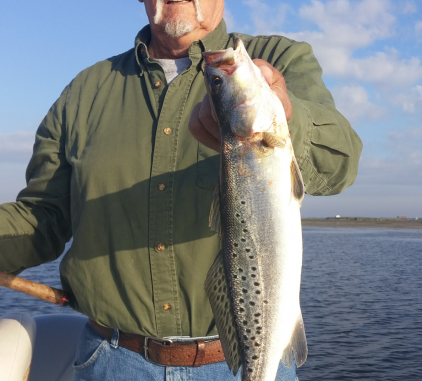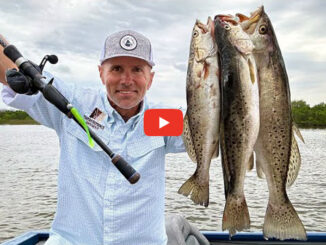
Oyster reefs and points in Sister Lake, Lake Mechant holding plenty of specks, guide says
Capt. Tommy Pellegrin said the speckled trout bite right now out of Dularge is tough to beat, with fish steadily coming over the gunnels two at a time on double-rigged soft plastics.
On Wednesday, one angler actually caught three white trout on a double rig — so you know the action is pretty special.
“They’re so thick, one of the fish hit the line and got tangled up with its teeth on the braid, so we caught three at one time,” said Pellegrin, with Custom Charters out of Houma. “That gives you an idea of how thick they are …. Sister Lake and Lake Mechant have tremendous amounts of fish in them. If you know where the oyster reefs are in the lakes, you should do well with nicer trout.
“Dularge is littered with billions of speckled trout. It’s unreal the numbers they have over there. You can go and catch two at a time for hours and hours. Now, only 1 to 5 percent are keepers if you stay under the birds out in open water. But if you concentrate on reefs and points — whether birds are there or not — you’re going to find bigger trout.”
A Berkley Rattle Shrimp about 18 inches under a popping cork has been his weapon of choice, but Pellegrin said it honestly doesn’t much matter what you’re throwing. A quarter-ounce jighead rigged up with a Berkley Gulp ghost shrimp will also get the job done.
“You don’t have to go deep, because these fish are feeding on shrimp that are jumping out of the water. Pretty much anything works: Double rigs, single rigs bounced on the bottom, a rattle shrimp under a cork,” he said. “They’re eating anything they can get their mouths around now. They’re having to fatten up for the winter, so they’re definitely fattening up now.”
Tidal movement is key to the bite, he said.
“Some spots a falling tide is better. Some spots an incoming tide is better,” he said. “But either way, you need some moving water — in or out. Either way, you’re going to catch.”
Pellegrin, who uses 20-pound braid for his main line along with a 30-pound mono leader, said the bite should last until the weather gets pretty chilly.
“This is going to stay until we get any kind of extreme cold front,” he said. “When the water temperature gets below 60 degrees, this fishing will slow down and they’re going to get more into the deeper spots.”
For more information, contact Pellegrin at 985-851-3304.


